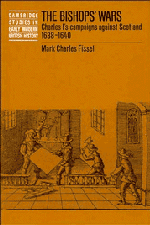Book contents
- Frontmatter
- Contents
- List of Maps
- Preface
- List of abbreviations
- 1 THE EVENTS OF THE BISHOPS' WARS AND CAROLINE POLITICS
- 2 INSTITUTIONS
- 3 MILITARY FINANCE
- 4 RELUCTANT LORDS AND ABSENT MERCENARIES
- 5 THE PERFECT MILITIA
- 6 IMPRESSMENT AND THE SUBSTITUTION CLAUSE
- 7 RIOT, ICONOCLASM, AND MURDER AMONGST THE SOLDIERY
- 8 CONCLUSION
- Bibliography
- Index
- Cambridge Studies in Early Modern British History
4 - RELUCTANT LORDS AND ABSENT MERCENARIES
Published online by Cambridge University Press: 03 May 2011
- Frontmatter
- Contents
- List of Maps
- Preface
- List of abbreviations
- 1 THE EVENTS OF THE BISHOPS' WARS AND CAROLINE POLITICS
- 2 INSTITUTIONS
- 3 MILITARY FINANCE
- 4 RELUCTANT LORDS AND ABSENT MERCENARIES
- 5 THE PERFECT MILITIA
- 6 IMPRESSMENT AND THE SUBSTITUTION CLAUSE
- 7 RIOT, ICONOCLASM, AND MURDER AMONGST THE SOLDIERY
- 8 CONCLUSION
- Bibliography
- Index
- Cambridge Studies in Early Modern British History
Summary
Nowhere is the traditional yet improvised nature of Charles's military plans more apparent than in the means by which he attempted to raise troops. The infantry of 1639 consisted of ‘select’ soldiers from the trained bands north of the Trent, supplemented by a press; the dragoons and cuirassiers were brought out by a feudal summons of the nobility, clergy, and gentry. In the Second Bishops' War the nobles played a minor role, called up very late in the campaign. In both Bishops' Wars, however, the King found mercenaries an attractive option. With no centralized militia system in Scotland, a small crack mercenary force supported by English trained bands could very well have won a pitched battle against the Covenanters. However, the financial weakness of the Crown made the hiring of mercenaries virtually impossible, and the King's machinations only cast further doubt on his motives for suppressing the Covenant by force.
THE SUMMONING OF THE NOBILITY
Before the Bishops' Wars, Charles conferred with Attorney-General Bankes regarding the Crown's authority to summon subjects to defend the border. Some feudal tenures obliged residents of the northern counties to serve in a defensive capacity in case of a Scottish war, although some of this legislation had been repealed after the accession of James I. The opinion given was that Charles could ‘command all holding offices and lands in the posts adjoining Scotland’ to arm themselves and await the King's command.
- Type
- Chapter
- Information
- The Bishops' WarsCharles I's Campaigns against Scotland, 1638–1640, pp. 152 - 173Publisher: Cambridge University PressPrint publication year: 1994



